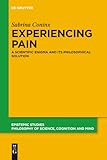Experiencing Pain : A Scientific Enigma and Its Philosophical Solution / Sabrina Coninx.
Material type: TextSeries: Epistemic Studies : Philosophy of Science, Cognition and Mind ; 44Publisher: Berlin ; Boston : De Gruyter, [2020]Copyright date: ©2020Description: 1 online resource (X, 190 p.)Content type:
TextSeries: Epistemic Studies : Philosophy of Science, Cognition and Mind ; 44Publisher: Berlin ; Boston : De Gruyter, [2020]Copyright date: ©2020Description: 1 online resource (X, 190 p.)Content type: - 9783110688375
- 9783110688474
- 9783110688405
- 128.4 23
- BJ1409 .C65 2020
- online - DeGruyter
- Issued also in print.
| Item type | Current library | Call number | URL | Status | Notes | Barcode | |
|---|---|---|---|---|---|---|---|
 eBook
eBook
|
Biblioteca "Angelicum" Pont. Univ. S.Tommaso d'Aquino Nuvola online | online - DeGruyter (Browse shelf(Opens below)) | Online access | Not for loan (Accesso limitato) | Accesso per gli utenti autorizzati / Access for authorized users | (dgr)9783110688405 |
Frontmatter -- Acknowledgments -- Contents -- Figures & Tables -- Introduction -- 1 Stage Setting -- 2 Synchronic Properties -- 3 Diachronic Properties -- 4 Family Resemblance -- 5 Conclusion -- References -- Name Index -- Subject Index
restricted access online access with authorization star
http://purl.org/coar/access_right/c_16ec
Although pain is one of the most fundamental and unique experiences we undergo in everyday life, it also constitutes one of the most enigmatic and frustrating subjects for many scientists. This book provides a detailed analysis of why this issue is grounded in the nature of pain itself. It also offers a philosophically driven solution of how we may still approach pain in a theoretically compelling and practically useful manner. Two main theses are defended: (i) Pain seems inscrutable because there exists no property that is commonly shared by all types of pain and that is at the same time particular to pain, setting it apart from other bodily sensations. This applies irrespective of whether we consider the psychological dimensions, neural networks, causal relations or biological functions of pain. Consequently, it is impossible to refer to ideal far-reaching and ideal distinct generalizations on the matter of pain. (ii) Despite this challenge, by focusing on the resemblance relations that hold across pains, we can generate scientific progress in explaining, predicting and treating pain. In doing so, the book aims to provide a clear conceptual basis for interdisciplinary communication and a useful heuristic for future research.
Issued also in print.
Mode of access: Internet via World Wide Web.
In English.
Description based on online resource; title from PDF title page (publisher's Web site, viewed 28. Feb 2023)


